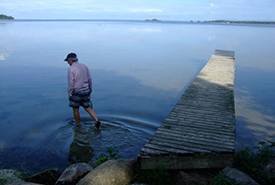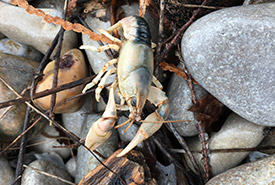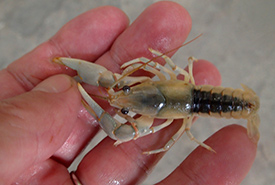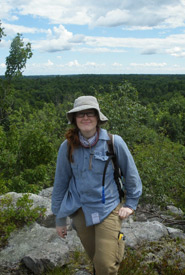Dr. Crayfish, I presume?

Premek Hamr, PhD (a.k.a. Dr. Crayfish) (Photo courtesy of Premek Hamr, PhD)
At the Nature Conservancy of Canada's annual Ontario Region staff meeting last May, a few of us stepped outside to wander the shoreline of Lake Simcoe and admire the sunset. As we rooted around the rocky beach, I took a few photos of plants and animals in the area to post on iNaturalist. I enjoy using this website to contribute to citizen science and learn about the species I see.
One of the creatures I saw was a small, light-coloured crayfish slowly poking around the beach. When I got home, I tried to identify the species through my photo. I don't know much about crayfish, and even learning how many native crayfish species there are in Ontario was new to me. I found an ID guide put out by Ontario Nature, and I made an educated guess that it was a northern clearwater crayfish.

Northern clearwater crayfish (Photo by NCC)
A few days later, other iNaturalist users saw my observation and confirmed the species. Not only did I learn a few new things about crayfish, but I also contributed one more data point to citizen science.
A few months later, I heard from another iNaturalist user who knows quite a bit about crayfish. His name is Premek Hamr, PhD, but he often goes by Dr. Crayfish. Dr. Crayfish teaches environmental science at Upper Canada College. He has been studying crayfish in Canada, Australia and Europe for the past 37 years.
He was very interested in my observation, as it appeared to be a rare white morph (colour variant) of the species. He asked for a few more details on it so he could investigate. My accidental observation of a species I wasn't even familiar with turned out to be useful to a researcher who studies them full time.
I asked him a few questions over email about how he uses citizen science to help inform his research.
Liv Monck-Whipp (LMW): What's the focus of your research?
Premek Hamr (PH): The focus of my present study is to the save the unique white morph population of the northern clearwater crayfish. This morph only occurs in Lake Simcoe (and nowhere else in North America). It is threatened by the expansion of the introduced rusty crayfish. Its extinction appears to be on the horizon.
LMW: Why were you particularly interested in the crayfish I observed?

The focus of Dr. Crayfish's present study is to save the unique white morph population of the northern clearwater crayfish (Photo by Premek Hamr, PhD)
PH: It is now very difficult to find white morph in the lake. Your observation was the most recent record, and I am presently trying to find more. Knowing the last place they have been seen lets me know where I can try to look for more.
LMW: Have you found many other useful observations on iNaturalist?
There are numerous useful records of Ontario crayfish on iNaturalist, including a very rare blue colour variant of the northern clearwater crayfish.
LMW: What do you do when you find a useful observation?
PH: When I find a useful record on iNaturalist, I usually contact the person who posted it for further information.
LMW: How did you start on iNaturalist, and how are you using it to inform your research?
PH: A fellow researcher from the U.S. introduced me to iNaturalist. I feel citizen science is extremely important. There are not as many studies about where species live (distribution surveys) being conducted these days due to lack of funding for this kind of fundamental and important research. This information is needed to document the reduction of the ranges of not only our native species, but also the numerous expanding introduced/invasive species.
To learn more about crayfish and their importance from Dr. Crayfish, click here. If you want to contribute your observations to citizen science, sign up for iNaturalist and/or eBird.


